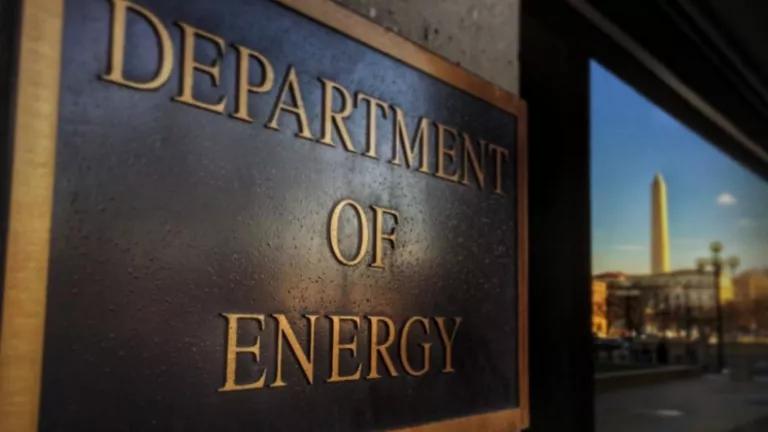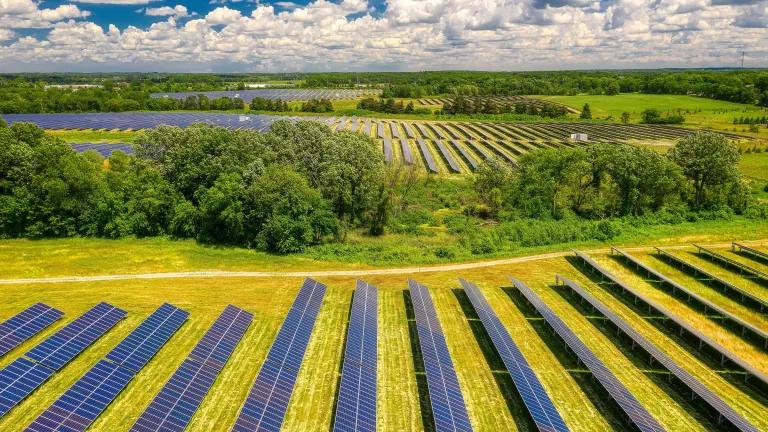Tepid Clean Energy Innovation Funding in FY22 Omnibus
Congress's recently passed package is a modest step forward for climate action relative to FY21 and includes increases in funding for several key clean energy innovation programs at the U.S. Department of Energy.

1. Climate crisis requires a step increase
Congress recently passed an omnibus spending bill for fiscal year 2022 (FY22). Overall, the package is a mixed bag (for an overview of the omnibus, check out Alexandra Adams’s blog). It is a modest step forward for climate action relative to FY21 and includes increases in funding for several key clean energy innovation programs at the U.S. Department of Energy (DOE). However, it falls considerably short of President Biden’s FY22 budget request as well as the House and Senate marks set last year. To reach net-zero emissions by 2050, investments in clean energy innovation should be commensurate with the scale of the climate challenge and need to see significantly higher increases in FY23 and beyond.
Clean energy innovation is essential to fighting climate change and supports many national goals, such as job creation, energy security, environmental responsibility, and economic competitiveness. It has been responsible for the dramatic cost reductions for clean energy technologies like wind and solar (e.g., DOE’s SunShot Initiative dropped solar power costs by a whopping 75 percent in six years), as well as cutting-edge solutions like floating offshore wind farms. Innovation within the clean energy landscape has also resulted in long-term job creation, and clean energy continues to be the biggest job creator in the U.S. energy sector, employing nearly three times the number of workers who work in fossil fuel extraction and generation.
2. The omnibus bill has a cohort of good provisions
The omnibus package continues this tradition of clean energy innovation at DOE through a number of measures. Below are some of the encouraging provisions included in the bill:
- Funding for crosscutting initiatives, such as those aimed at energy storage and industrial decarbonization. These are critical levers to achieve our climate goals and require concerted research, development, and deployment (RD&D) efforts in this decade to bring solutions to commercial viability.
- Increased funding for technologies to advance hydrogen use in certain applications. Green hydrogen has the potential to play a key role in deeply decarbonizing heavy industrial processes—like steelmaking—that may have few other clean energy alternatives. Advancing green hydrogen for industrial applications requires focused RD&D efforts in this decade and we are advocating to make this as clean and safe as possible.
- An expansion in solar energy innovation that includes:
- Support for cadmium telluride (CdTe) photovoltaics (PV) to advance low-cost manufacturing techniques and domestic research capabilities. CdTe is a cheaper and more efficiently manufactured alternative to conventional silicon-based solar.
- Funding to research and commercialize perovskites, which could serve as cheaper, more efficient, and lighter-weight solar cells than silicon-based solar.
- Support for innovative offshore wind demonstration projects. Offshore wind is poised to play an important role in our clean energy systems and has the potential to supply nearly double the nation’s current electricity use but still requires focused RD&D to lower costs, increase compatibility with marine wildlife, and increase deployment.
- Research and demonstration of on-site manufacturing of larger wind turbines. On-site manufacturing of turbines would enable the construction of larger and taller towers, allowing us to take advantage of low-cost wind resources and harness stronger wind energy.
- Direction to decarbonize steelmaking. Steel is one of most challenging sectors to fully decarbonize, and this direction is a positive step toward developing necessary solutions to producing zero-emission steel at scale in the United States.
- Encouragement to focus on whole-building decarbonization and technologies, like heat pumps, that are critical to lowering energy costs and emissions in the building sector.
3. We need significantly more funding for clean energy RD&D to facilitate an affordable and reliable transition to a clean economy, particularly energy end-use sectors.
Despite this progress, a significant increase in funding for clean energy RD&D is needed now more than ever. We need to create a robust slate of clean energy alternatives in several sectors, such as aviation, shipping, steel, and cement. Although some clean energy technologies like wind and solar are competitive and reliable, more investments in innovation can help to drive further cost reductions and make them even more competitive.
While the FY22 omnibus includes increased funding for clean energy innovation relative to FY21, it severely underfunds the Office of Energy Efficiency & Renewable Energy (EERE) across the board when compared to President Biden’s budget request, as well as both the House and Senate proposals (comparison table below). EERE is DOE’s central office for decarbonizing our electrical grid as well as the industrial, transportation, and building sectors. The increases that we do see also skew toward the electricity-generating technologies and underfund RD&D for the transportation, buildings, and industrial sectors relative to their share of greenhouse gas (GHG) emissions. This further exacerbates long-standing imbalances, whereby energy end uses (e.g., industry, transportation, buildings) are significantly more underfunded relative to energy production (e.g., renewable energy, fuels).


More broadly, these funding levels fall far short of the levels needed to put us on a trajectory to limit global temperature rise to 1.5 degrees Celsius. For example, Environmental Defense Fund’s Climate Innovation Blueprint calls for clean energy RD&D funding at DOE to reach $32 billion annually by the end of Biden’s first term and roughly $38 billion by FY30 in order to reach net-zero by 2050. This is a tall order, considering that DOE’s current clean energy RD&D programs are estimated to total only about $7 billion. Other reports have also recommended significant increases in annual clean energy innovation funding—Bill Gates called for a fivefold increase; a 2021 interdisciplinary study on deep decarbonization from the National Academies of Sciences, Engineering, and Medicine recommended increasing funding to $20 billion; and Information Technology & Innovation Foundation’s Energizing Innovation report suggests a quadrupling of government-wide clean energy RD&D spending over the next four years. By ignoring the many calls to increase clean energy innovation funding, we run the risk of failing to reach our clean energy targets while also further marginalizing the people who are most vulnerable to climate change and those who carry the highest energy burdens.
4. Achieving an affordable and efficient transition to a clean economy requires significantly more funding for end-use sectors and a more prominent role for the DOE's Office of Policy
The omnibus is a step in the right direction. But clean energy funding levels are insufficient and leave us vulnerable to missing our climate and clean energy goals; they also put us at a competitive disadvantage relative to the many other countries that are investing heavily in this space in order to lead the global clean energy transition. To ensure we stay on the right path toward net-zero by 2050, NRDC has identified a set of key needs, including but not limited to:
- Significantly increasing funding for EERE offices, with a particular focus on buildings, vehicles, and industry, which have been historically underfunded relative to the contribution of those sectors to emissions.
- Better integrating the Office of Policy and individual technology offices to achieve the most affordable and beneficial transition to a clean economy. The Office of Policy generally conducts economy-wide, holistic analyses of technology pathways for the United States to achieve climate goals. We have a short window of time to develop the necessary solutions to meet our 2030 and 2050 climate goals; therefore, we need strategic RD&D prioritization and focus in this decade into the technologies that would support the most efficient pathways to a net-zero GHG economy by 2050, and that would also deliver the most economic and public health benefits to Americans. A more robust integration between the Office of Policy and technology offices is foundational to deliver on this vision and enable optimal leveraging of taxpayer dollars toward a unified goal. Congress should appropriate significantly more funds to the Office of Policy to successfully fill this role.




